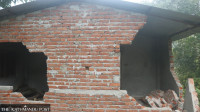Lumbini Province
Riverbank settlements in Bardiya at high risk of floods
Lack of permanent embankments on river is giving sleepless nights to residents.
Kamal Panthi
Prahlad Bhatta, a local resident of Tihuni in Ward No. 3 of Rajapur Municipality, Bardiya has not had a day’s rest since the rains began early June.
Bhatta’s house is close to the Karnali river and at risk of inundation in case of floods in the river.
“I go to the riverbanks every night with a torch in hand to check the water level in the river,” he said. “The river has caused great damage to our village in the past. This year too, it is threatening to breach its embankments and flood the village.”
Like Bhatta, Suresh Chaudhary of the same village also walks to the riverbanks every day to check the water level.
“I haven’t had a good night’s sleep since the monsoon began. The construction of the embankments is still not complete, which makes me very anxious,” Chaudhary said.
According to the villagers, they are preparing to move to a safe location since floodwaters have started seeping into the village. “There is a high risk of inundation so some of us are preparing to move away,” said Bhatta.
The flooded Karnali river has already swept away some gabion boxes filled with stones that were installed earlier this month to stop the floodwaters from eroding the riverbank area.
Bhojraj Joshi, a local resident of Rajapur Ward No. 1, also a former member of the District Development Committee in Bardiya, said, “People living near the riverbank areas in Rajapur Municipality and Geruwa Rural Municipality are in direct threat of floods and inundation. There are no embankments in these areas.”
For the last one month, the local administration has been pressuring the Karnali River Management Office to carry out construction works on the embankment. But since the rains haven’t let up, construction work hasn’t gained pace, said Santa Bahadur Sunar, chief district officer of Bardiya.
“We had asked the Karnali River Management Project to speed up the construction of embankments. But then the pandemic and the prohibitory orders put all construction works to a stop,” said Sunar.
According to the project office, 43 kilometres of embankment need to be constructed in Karnali and Geruwa river bank areas. Thirty kilometres of embankment is to be constructed in Karnali and 13 kilometres in Geruwa river areas.
“The construction work started seven years ago but there has been no progress,” said Shankar Tharu, a local resident of Rajapur.
Dharma Kumar Neupane, chief of the project, cites budget shortage as the main reason for the delay.
The estimated cost of the project is around Rs 11 billion.
Some villages in Nawalparasi (West) are also at risk of inundation and flooding as the Narayani river and other streams in the district are all rain-fed and gaining strength.
Jitendra Harijan, a resident of Palhinandan Ward No. 1 in Nawalparasi (West), said, “My house was inundated last week. All of the food grains have gone to waste. We are looking at more difficult days ahead.”
Over 50 houses in the settlement face inundation every monsoon. “However, none of the concerned authorities has taken initiatives to address our issue,” said Harijan.
A Musahar settlement in Pratappur Rural Municipality gets waterlogged every monsoon but little has been done over the years to mitigate the risk of flooding.
“Our settlement gets inundated every monsoon, as there is no proper drainage system to let the floodwaters pass,” said Rabindra Chaudhary, a local resident of Pratappur Ward No. 6.
The settlements of Shankarpur, Rampur Khadauna and Maheshpur in Panlinandan Rural Municipality; Pusauli and Bhujahawa in Sarawal Rural Municipality; and wards. 3 and 4 in Pratappur Rural Municipality and Susta Rural Municipality also get waterlogged every year in monsoon.
However, Baiju Prasad Gupta, chairman of Panlinandan Rural Municipality, says the local level does not have the capacity to initiate flood control measures by itself.
“We have only been able to manage rescue and relief. Floods and inundation are recurring problems and it needs intervention from the federal level,” he said.
In Banke, settlements in Rapti Sonari, Daduwa and Narainapur rural municipalities are also at risk of floods.
“Five years ago, the flooded Rapti river displaced over 300 families in Holiya of Daduwa Rural Municipality. The displaced families are still living under huts near the riverbank area. They are unwilling to move from the site,” said Pateshwor Kurmi, ward chairman of Daduwa Ward No. 1.
According to the office of Daduwa Rural Municipality, it has built a building for the displaced families to take shelter in.
The settlements in Narainapur Rural Municipality are also at risk of flooding due to the rain-swollen Rapti river. Laxmi Kanta Mishra, an official at the Disaster Management Committee in the rural municipality, said, “People living near the riverbank areas of wards 1 to 5 are at high risk of floods. We have established shelters for the flood victims in three different places of the rural municipality.”
On Thursday, a team of officials from the District Administration Office, District Police Office and the local units inspected the flood-affected areas in Banke district
“Settlements in Narainapur, Daduwa and Raptisonari are at high risk of flooding. It has been estimated that at least 10,000 individuals will be affected by floods and inundation during this monsoon in Banke,” said Rupan Gyawali, an official from the team.
According to Shivalal Gelal, chief district officer of Banke, his office has raised awareness on the threat of floods in riverbank settlements.
“We have advised them to stay alert and safe. Authorities have also been advised to make preparations for the management of possible disasters,” Gelal said.
(Nabin Paudel in Parasi and Madhu Shahi in Banke contributed reporting.)




 5.31°C Kathmandu
5.31°C Kathmandu













